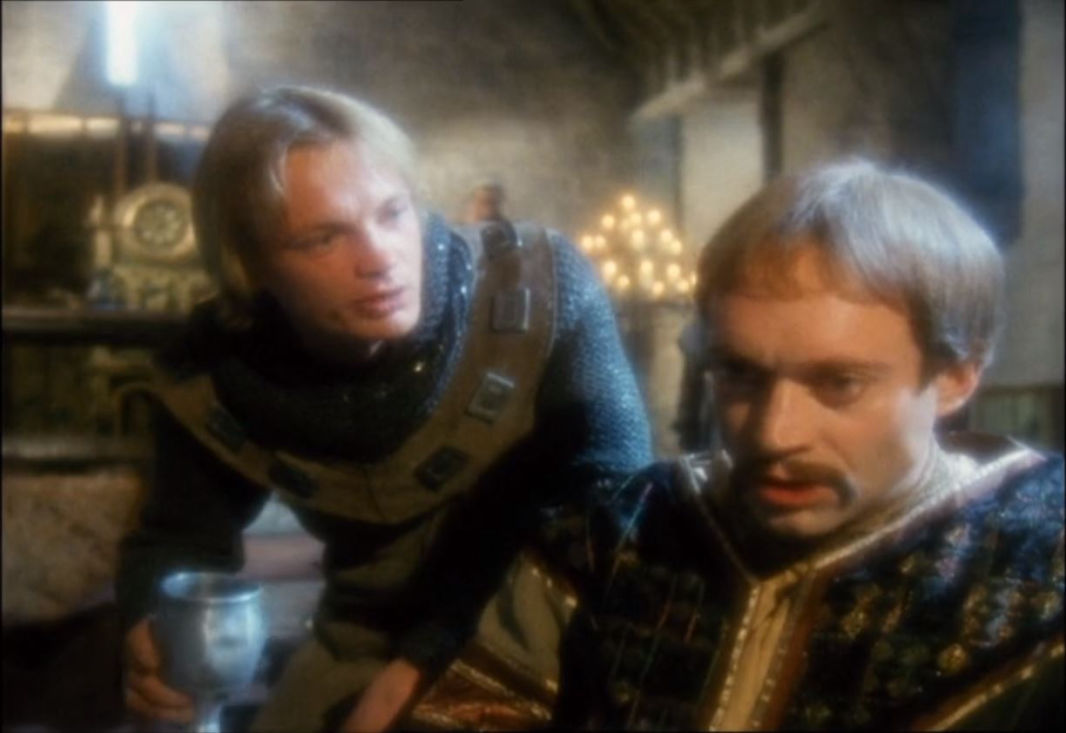
VIDEO CLIP:
GISBURNE: It’s always Robin Hood. Robin Hood! Anyone would think he was the only wolfshead in Sherwood.
SHERIFF: But he is, Gisburne. The only one that matters.
GISBURNE: You made him what he is. Robin Hood and the Sheriff of Nottingham. You’re two sides of the same coin.
SHERIFF: What? You forget who you are speaking to!
- Robin of Sherwood: "The Sheriff of Nottingham", written by Anthony Horowitz <1>

That observation might be out of character for the usually dense Guy of Gisburne, but it’s a statement that echos the opinion of Robin Hood historians. In looking at the corruption of real medieval sheriffs and the early Robin Hood ballads, R.B. Dobson and J. Taylor say that the sheriff “plays so fundamental a role in the legend that he may have been more crucial to its origins than Robin Hood himself.”<2> The sheriff has been a figure in the Robin Hood legend from the earliest ballads to the present day. This paper will examine a handful of sheriffs in modern television shows, films and novels, and explore how the portrayal of the sheriff affects the nature of Robin Hood himself.
J.C. Holt notes that in the early ballad, A Gest of Robyn Hode, the sheriff has two different natures. In the third fytte, the sheriff is a “laughing stock,” but later in the fifth fytte, he’s “menacing and villainous.”<3> The tone of the ballads vary and so does the sheriff. He’s not threatening in the light Robin Hood and the Potter, and much more threatening in the darker Robin Hood and Guy of Gisborne ballad. The sheriff is such a cypher, a symbol of an office, that he doesn’t even merit a proper name.
Although the sheriff figures prominently in all of the surviving early ballads, he makes only a handful of appearances in later ballads. Instead, Robin Hood often has inconsequential fights with various tradesmen, often recruiting them for his band. Also, the sheriff is sometimes ignored or absent in film and television versions of the legend. He’s a third wheel and lackey of Prince John and Sir Guy in both the Errol Flynn and Douglas Fairbanks films. Prince John and powerful Norman barons are also the primary adversaries on The New Adventures of Robin Hood, where in four seasons, the villainous sheriff has only made a few token appearances.
I believe there are three reasons for the absence of the sheriff from some versions of the legend. First, the late medieval audience of the earliest ballads was only too familiar with the corruption of sheriffs. So familiar that the real-life offences that sheriffs have been charged with – such as bribery or running protection rackets in league with real outlaws – are not even detailed in the early Robin Hood ballads. The sheriff of Nottingham was not going to be a good guy, that was understood. As systems of governments changed and as the legend moved to other countries, the role of the sheriff in real society was reduced and changed. Although general sympathy for the underdog remained, resistance to authority in the specific form of the sheriff was not something people immediately identified with any longer.
Also, Stephen Knight notes that the early legend had a localized feel. As Robin Hood became a noble and a heroic figure defending and representing the entire country, it may seem to some to be a bit petty to have a mere sheriff as his ultimate enemy. Prince John can be a threat to all England, not merely one shire.
Finally, some may have been uncomfortable with the sheriff’s role as a man of the law. Resisting robber barons and Prince John is less radical. Prince John is a “usurper” and robber barons are private thugs. Instead of rebelling against the system, Robin is defending the system against outside intruders. Robin Hood becomes the lawman facing criminal opponents. By making the sheriff merely a lackey of Prince John, the sheriff’s legal authority is called into question.
In the 1950s television series The Adventures of Robin Hood starring Richard Greene, the sheriffs are also loyal servants of Prince John, but the sheriff is a major character where as Prince John is only an occasional guest star. I said “sheriffs,” because there were two sheriffs in the series. Alan Wheatley played the “High Sheriff of Nottingham” for the series’ first three seasons. When Wheatley chose to leave the series, the sheriff was replaced by a new “High Deputy Sheriff of Nottingham” played by John Arnatt. The deputy or undersheriff is a historical function that rarely appears in Robin Hood tales. However, the Richard Greene series would use much from real history. For example, in one episode the sheriff evokes the law of “hue and cry” to seize a runaway serf. But the serf remains uncaptured for a “year and a day” within the city walls of Nottingham. In accordance with “the letter of the law” that the sheriff repeatedly claims to uphold, the sheriff reluctantly grants the serf his freedom. As the sheriff says to Marian, “Since at the moment, my dear, I can see no alternative, let justice be done.”<4>
Echoing the offences of the historical sheriffs, the sheriffs in this TV series may claim to only be acting in the interests of justice, but more often than not – a bribe was a strong motivating factor.<5> Friends of Prince John would also get special treatment.<6> In one episode, the sheriff guarantees Robin Hood safe conduct to an archery contest on the understanding that the sheriff will share in the contest’s prize. In fact, the sheriff was misled as to the size of the prize. When he learns that the prize is considerably less than promised, the sheriff withdraws his grant of safe conduct as it was given under false pretences. As the sheriff moves to arrest Robin, Marian intercedes and says “that sounds a strange conversation, milord. If I didn’t know you so well, I could almost believe that you granted this man safe conduct in exchange for a bribe.” Unable to admit his wrongdoing, the sheriff is forced to let Robin Hood go free.<7>
In this series, there are limits to the sheriffs’ power. The sheriffs are like corrupt politicians who must act in secret for fear of reprisals. These sheriffs can obviously be held accountable for their wrongdoing, unlike many sheriffs who can be openly villainous. These limits on the sheriffs’ legal power enables Robin Hood to outwit them by appealing to the law. Robin Hood, who Stephen Knight compares to a World War II squadron leader, becomes a force for authority. The sheriffs like real world politicians can be held accountable if they are caught. Some medieval sheriffs were caught and outlawed for such practices.
This suggests that there is a just and good set of laws that the sheriffs bend and break. When King Richard returns the just laws will be restored, and Robin once tells the sheriff that then it be the sheriff’s turn to wear a noose.<8> This clearly casts Robin Hood in the role of trying to restore the just status quo – something that J.C. Holt feels was Robin’s role in the early ballads. By establishing limits on the sheriffs’ authority, the series also establishes limits on Robin Hood’s rebellion.
The scene I’m about to show demonstrates some of these points. Learning of an argument between Robin Hood and Little John, the (deputy) sheriff offers Little John a free pardon, claiming that as a man of the law he’s looked over the evidence and Little John should not have been outlawed. A bit suspicious at first, Little John is glad to accept the pardon. But he soon reconsiders.
VIDEO CLIP (1 minute)
LITTLE JOHN: Sheriff?
SHERIFF: Yes, Little John.
LITTLE JOHN: You’re a liar.
SHERIFF: I beg your pardon.
LITTLE JOHN: I said you’re a liar! You said I didn’t deserve to be outlawed. I’ve thought about it – I should have been.
SHERIFF: My dear fellow, you had every right to do what you did.
LITTLE JOHN: Under any decent man’s law, yes. Under King Richard’s law, yes. Under Prince John’s law, no! And you’re Prince John’s man!
SHERIFF: Oh really, you’ve got the thing in your hand. Be as guilty as you like, it can’t be helped now. As far as I’m concerned, you’re free and the pardon proves it.
LITTLE JOHN: Oh no, no, that’s not what the pardon proves. The pardon proves that you want to break up Robin Hood’s band. The pardon proves that you want to shout out to the whole country that you’re a merciful man, and you’re not! The pardon proves that any man who wants to leave Robin Hood’s band and live under the law of tyrant can do so by toadying to you!
SHERIFF: You haven’t toadied. You’re being a complete nuisance even now, but I can’t go back on my word.
LITTLE JOHN: Listen, I don’t want your pardon. The freer it makes me, the less I want it!
- The Adventures of Robin Hood: "Goodbye, Little John", written by Raymond Bowers<9>
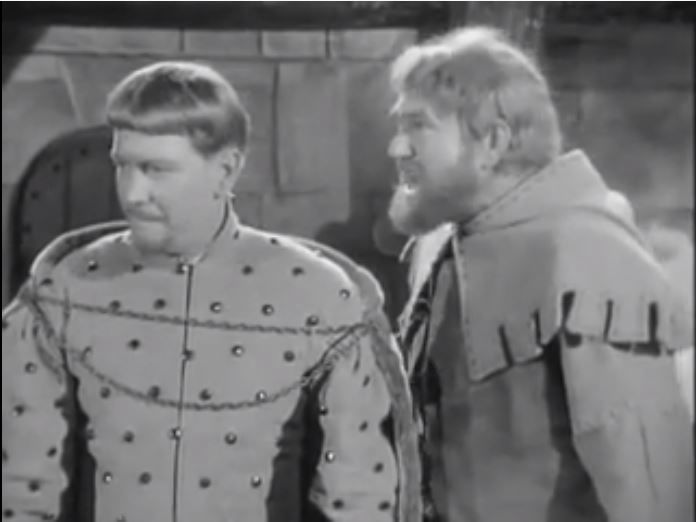
Because of the association with Prince John, the sheriff’s authority in that scene is tainted. But in ballads such as Robin Hood and the Monk and Robin Hood and the Golden Arrow, the sheriff takes his authority – however he misuses it – directly from the lawful king. The Sheriff of Nottingham in the 1980s British TV series Robin of Sherwood serves the king, not only King John in the later episodes, but King Richard as well.
Unlike the sheriff of the ballads and most TV and movie sheriffs, the sheriff in Robin of Sherwood has a name. He’s Robert de Rainault, played with villainous delight by Nickolas Grace. Like in the ballads, this sheriff can somewhat schizophrenically represent different attitudes and approaches. In some episodes, he balks at destroying villages because that will make the peasants more rebellious.<10> In others, he destroys villages or threats to clear villages of all men, women and children.<11> He can be comically humiliated by Robin Hood in one episode, and be a deadly threat in another.<12> And sometimes, de Rainault is even allowed to beat Robin Hood. At the end of the episode “Alan a Dale”, Robin Hood rescues the sheriff’s bride to be. But as misogynist, the sheriff is glad not to marry “that silly female” and he was able to keep Robin Hood from stealing the dowry, although he made it look like the outlaws stole the dowry so that the bride’s father couldn’t ask for it back. A darker victory comes when Michael Praed chose to leave the series, his Robin of Loxley was killed by the sheriff and his soldiers. This victory is short-lived, when a new character assumes the mantle of Robin Hood. However, even this temporary victory is a radical departure from the standard Robin Hood legend where the sheriff is always doomed to failure.
But then Robin of Sherwood is a very radical series. The outlaws are portrayed somewhat like radical student protestors, and they don’t seek a restoration to the status quo. Rampant villainy is the status quo. In her article on the left-wing politics of Robin of Sherwood, Laura Blunk writes “In contrast to the earlier versions of the legend which find Robin and his Merry Men opposing corrupt individuals while supporting legitimate and justly administered authority, Robin of Sherwood presents a tale of revolutionaries opposing a corrupt system.”<13> A prime example that Blunk cites is when the supposedly “good” King Richard actually plots with the sheriff to assassinate Robin Hood.<14>
De Rainault does not have to conceal his villainy. Nickolas Grace’s portrayal of the sheriff isn’t that radical taken by itself, it’s the changes to the world that the sheriff operates in that are radical. The sheriff is as corrupt and evil as ever, but now the established hierarchy supports his villainy. This Thatcherite political system perfectly suits a long-haired messianic Robin who seeks to overturn society’s cruel conventions.
On the other hand, Alan Rickman’s portrayal of the sheriff in Robin Hood: Prince of Thieves seeks to overturn the established social hierarchy. Usually, it’s Prince John who seeks to seize the throne, but here the sheriff leads the evil and traitorous movement. Although the sheriff collects tax money and posts a reward for Robin’s capture, there’s almost no sense that the sheriff has any kind of legal authority, even the false law of a usurping prince. Whether or not the system was corrupt, the sheriffs in the 1950s and 1980s British TV series were held accountable for their actions. Here the only sign of proper authority is a brief cameo of King Richard at the end, which comes after Robin has killed the sheriff. Robin’s outlawry is not anti-authoritarian, because the only “authority” figures in this film have all the legal sanction of school yard bullies.
Dangerous, psychotic and unbelievable schoolyard bullies, that is. Rickman’s sheriff does goes through every villainous cliché. He destroys villages, hires cannibalistic thugs, kills his own henchman in a moment of displeasure. The sheriff rants, raves and even attempts to rape. He vows to cut Robin’s heart out with a spoon.
This scene begins with a humourous, almost social-realistic comment on Robin’s activities and ends in pantomime badness.
VIDEO CLIP (54 seconds.)
SCRIBE: We reckon he’s nicked three to four million in the last five months, sire.
SHERIFF: Alright then, fine. Raise the bounty on his head. 25,000 crowns.
SCRIBE: Begging your pardon, sire. It won’t do no good how much you raise it.
SHERIFF: Really, scribe? And why is that?
SCRIBE: Well, the poor you see, he gives them what he takes. So, well, sire. They love him.
SHERIFF: Just a minute. Robin Hood steals money from my pocket, forcing me to hurt the public ... and they love him for it?
SCRIBE: Yes.
SHERIFF: That’s it, then! Cancel the kitchen scraps for lepers and orphans! No more merciful beheadings! And call off Christmas!
- Robin Hood: Prince of Thieves, written by Pen Densham and John Watson
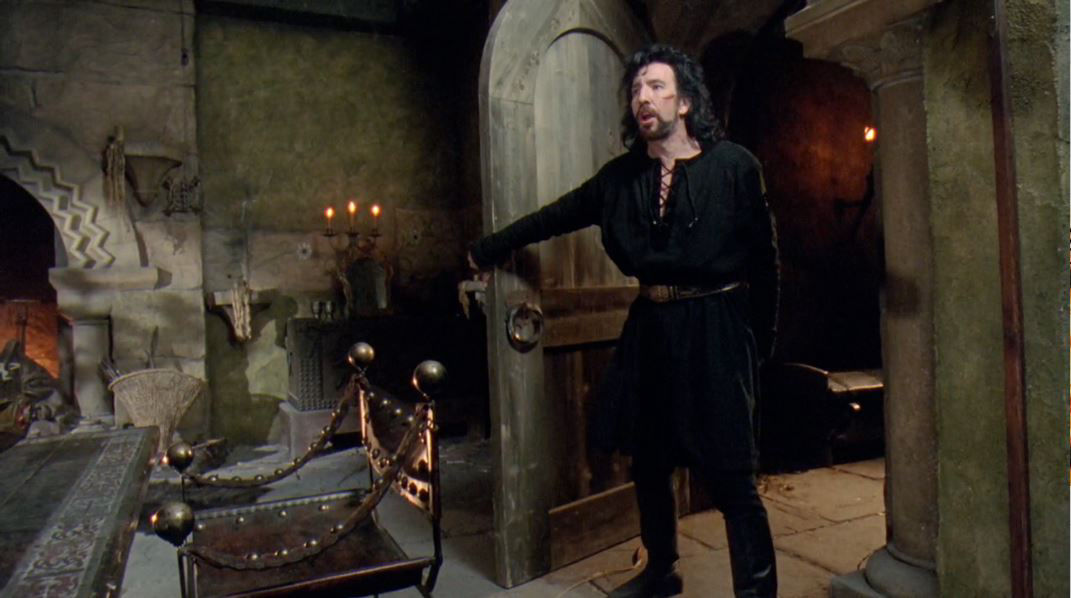
To quote Stephen Knight, “When the most quoted line from a Robin Hood film is the sheriff shrieking ... ‘And call off Christmas’, it is evident that something is wrong with the tone and overall balance of this version of the heroic myth.”<15> Indeed, this sheriff is so delightfully evil that he’s very funny and the most popular character of the movie. The movie was re-edited at the last minute because audiences were siding too much with the sheriff against Costner’s bland Robin.<16> Robin Hood in this film is the stern authority figure, and the sheriff is the funny, tricksterish rebel. It’s as if the characters switched personalities. However, now stern authority is considered desireable. This movie supports the system, it doesn’t rebel against it.
The sheriff is such a comic book character that people can root for him and not feel like they are supporting corrupt or cruel authority. It’s hard to relate any real-life authority figures to this panto baddie. Likewise, rebelling against such a cartoon figure doesn’t condone the rebellion against a society that even has a pretense of sanity. By exaggerating the villain, Prince of Thieves is devoid of true anti-authoritarian sentiment, quite unlike Robin of Sherwood, even though Prince of Thieves borrowed heavily from that show.
An unusual – and infinitely more subtle – approach to the sheriff can be found in the 1976 film Robin and Marian. Robert Shaw’s sheriff is almost the exact opposite of Rickman’s. Rickman’s sheriff is impatient, whereas Shaw’s sheriff waits for Robin to act. Rickman kills his own henchmen. Shaw looks over his soldiers’ corpses as says “I should have taught you better” with genuine regret at the loss of life.
This scene shows Robin and the sheriff meeting again for the first time in 20 years.
VIDEO CLIP (48 seconds.)
ROBIN: My lord sheriff. (Bows.)
SHERIFF: Robin. (Smiles affectionately.) Still not dead?
ROBIN: Not for want of trying. You look well – all things considered.
SHERIFF: How was the crusade?
ROBIN: A disappointment. After all these years, look at us. I’m nothing but a former captain, and you’re still the sheriff.
SHERIFF: No advancement. You see I can read and write, it makes you suspect. Not a duke in twenty reads a word. Correct, my lord?
SIR RANULF: Books are for clerks.
- Robin and Marian, written by James Goldman
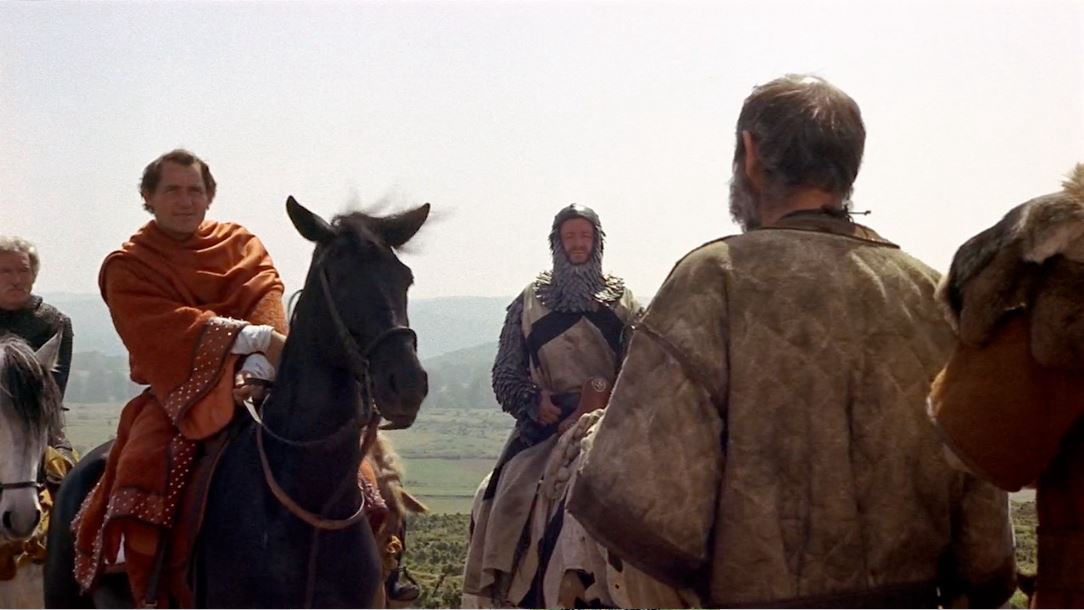
I see a genuine fondness between the two men. Kevin Harty notes that the sheriff is wiser and more compassionate than Sean Connery’s Robin.<17> In the ballads Robin expresses joy that the sheriff has met a justly bad end.<18> But in this movie after Robin slays the sheriff in single combat, he confides to Marian that the sheriff was the better man.
Harty says of this about the final battle: “The two are too old for this battle; they are like two middle-aged weekend warriors bent on recapturing the real – or imagined – glories of their long-gone youth be it on the basketball court or some more serious arena of combat.”<19>
By having an amiable and compassionate sheriff, Robin’s quest for past glories seems all the more quixotic. While there are cruel enemies such as the unrepentant illiterate Sir Ranulf, in this film, Robin’s most infamous foe seems unjustly villified by the ballads. Shaw’s portrayal of the sheriff suits a movie where Robin readily admits that his ballad exploits are fiction.
Stephen Knight says that Robin and Marian has a “‘one-off’ quality” not repeated by anyone else.<20> That may be true of films, but a positive portrayal of the sheriff has appeared in novels. While sheriffs in print are still villainous, such as the master manipulator in Jennifer Roberson’s novels, at least three writers move the sheriff beyond being a standard bad guy. Telling the story from the sheriff’s point of view is only one of many approaches to the Robin Hood legend in modern fiction. In an attempt to expand the legend from short ballads to fill hundreds of pages, the novels are a genre of “one-off” tales.
Parke Godwin’s novels Sherwood and Robin and the King are set over 100 years before most Robin Hood books, in the reigns of William the Conqueror and William Rufus. In these books, the sheriff is Ralf Fitz-Gerald, bastard son of a Norman knight, who rose to his position due to his skill in the conquest of England. By contrast, Robin Hood is really Edward Aelredson, the thane of Denby and was born with a silver spoon in his mouth. Godwin says of the characters: “Throughout their lives, circling each other, this profound difference made them natural opposites and enemies: Robin had and Ralf wanted.”<21> This is one result of the trend towards gentrification – Robin Hood is now higher-born than the sheriff.
Ralf is a good sheriff – although the denizens of Nottinghamshire are opposed to Norman rule, they find Ralf to be “the best of a bad lot”.<22> He’s a bit of hard at times, but fair and willing to punish Normans for his crimes as well as Saxons. His romantic feelings towards Marian were partially reciprocated, and he never pursued her with the criminal vigour of Alan Rickman’s sheriff or the sheriff in Roberson’s novels. By the end of Sherwood, Ralf and Robin have become aligned in a common cause. Ralf tells his wife, a relation of Robin’s, that he and Robin are “respectful enemies.”<23> By the beginning of the second book, they are clearly friends.
The Robin of these novels is not truly anti-authoritarian. For example, he sides with his Norman rulers against a Saxon earl. Robin is initially comes into conflict with Norman authorities because Ralf puts out the eyes of Robin’s friend, for violation of the forest offences. The supposed “laws of Canute” that Ralf uses to reach this decision were forgeries. Robin insists that the Normans follow the proper written legal precedent. In Robin and the King, Robin runs afoul of the king when he once again complains of a miscarriage of royal justice. He drafts a legal document, seeking to impose limits on the king’s authority. Sheriff Ralf reluctantly supports Robin’s document. Once, Robin explains to his men that while he agrees that a king is needed, the system requires “bars and checks”. Robin stands for American-style jurisprudence and “check and balances”. He wishes to establish a system which is the status quo in the modern day, and which existed in the novels’ recently-passed Saxon golden age.
Nor is Ralf Fitz-Gerald the only good sheriff working in a flawed system. Geoffrey, the sheriff of Nottingham, is the main character in Michael Cadnum’s young adult novel In a Dark Wood. When Robin meets the sheriff, he’s surprised and bit disappointed that Geoffrey is not a stereotypical villain. Geoffrey is not exceedingly cruel, he winces when his men are required to torture victims. His main fault is that he is slave to duty, a joyless man. With a flawed but basically good sheriff, Robin seems less of a social rebel and more a youthful prankster. Geoffrey and Robin reach an understanding when Robin saves the sheriff from a wild boar and when Geoffrey repays the favour by releasing Will Scarlet. The sheriff sees this understanding as victory.
A sheriff even more virtuous than Ralf or Geoffrey is Philip Mark, a real-life sheriff from the reign of King John. His exploits form the basis of Richard Kluger’s historical novel The Sheriff of Nottingham. While Godwin’s novels show the viewpoints of many characters and Cadnum’s book focuses on how the sheriff interacts with Robin Hood, Kluger’s novel deals with wider concerns than Robin Hood. Robin is a lesser character, seeming only to appear because a novel about the Nottinghamshire sheriff requires a Robin Hood appearance.
Historical documents suggest that the real Philip Mark may have been corrupt, but his fictional counterpart is a paragon of virtue. Kluger’s Philip steadfastly refuses to be bribed or bought and tries to stop his bailiffs from extorting money. He cares and tries to do right by the people of the shire. In the early ballads, it’s the sheriff who breaks his oath. In this novel, honest Philip is betrayed by friends, his brother, his wife and his loyal clerk. When his dismissal is announced, the populace is delighted – for all his good work, the common people still hate the tax man. As a loyal servant of King John, the sheriff is party to a monstrous act. Philip is ordered to carry out the execution of Welsh children being held in the castle. Although he contemplates rebelling, Philip carries out his dread orders, only sparing one hostage.
Robin Hood, who’s real name is Stuckey Woodfinch, does hold the sheriff accountable for this act. But it is the system that Philip works for which is at fault. If other sheriffs like the ones in the 1950s TV series are bad people corrupting good laws, Kluger’s sheriff is a good man seeking to improve bad laws.
Like Godwin’s sheriff, Philip Mark is a low-born bastard. He is never knighted even though he does want the privilege. The medieval Robin is a yeoman who imitates courtly virtues while holding a feast. Kluger’s sheriff is more virtuous than any knight around hin. Although Philip doesn’t rebel – even when given a good cause – there is still some of the traditional Robin Hood in him. And when he takes on Robin’s qualities, Robin is reduced to being a partying but amiable ne’er-do-well.
However, Kluger’s novel isn’t the only modern appearance of Philip Mark. In an episode of Robin of Sherwood also called “The Sheriff of Nottingham”, the regular sheriff Robert de Rainault is fired and temporarily replaced by Philip Mark. This Philip arrests three women and three children without cause and sentences them to death – unless Robin Hood surrenders himself.
VIDEO CLIP (31 seconds)
SHERIFF: Do you really believe that Robin Hood will just walk in here in give himself up?
PHILIP MARK: Mmm-hmm. What else can he do?
SHERIFF: He won’t come.
PHILIP MARK: Then the six shall die. And six more the next day. And six the day after that. If necessary, I shall keep on killing until your people’s hero has no more people left.
- Robin of Sherwood: "The Sheriff of Nottingham", written by Anthony Horowitz
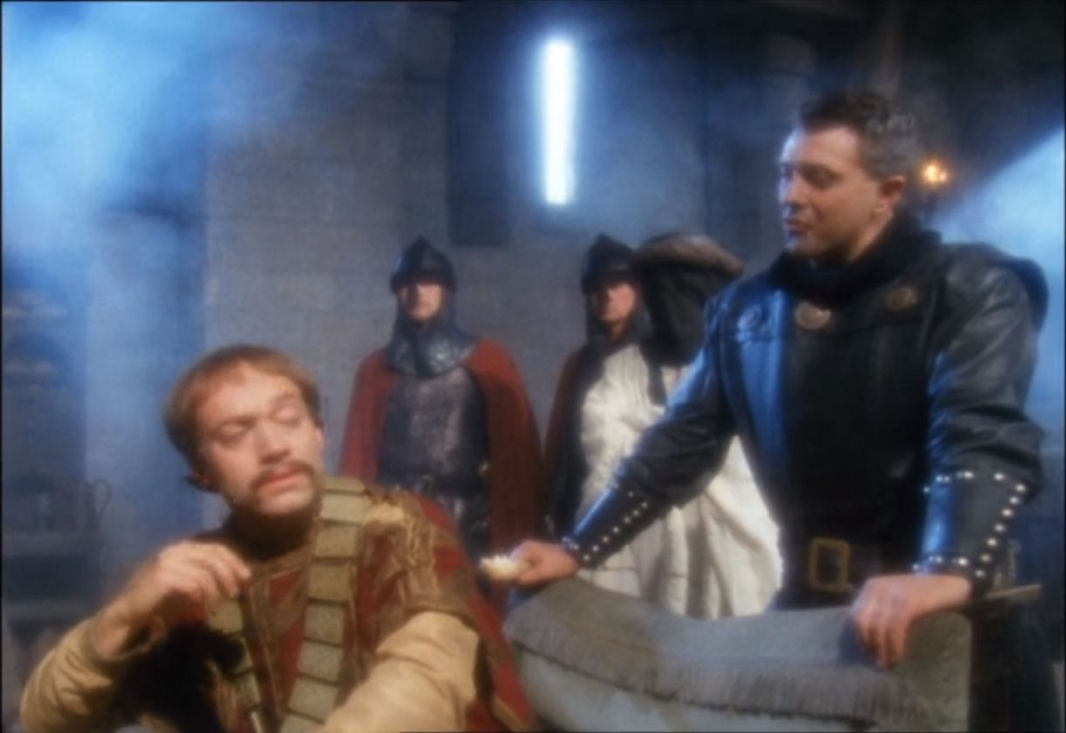
Although these sheriffs share the same name – and it is very common for sheriffs in novels to be referred to by their proper names, their natures are very different. One is a thoroughly evil villain, the other is just misunderstood. If Robin Hood can undergo many permutations, so can his greatest adversary.
I apologize as the end notes were clearly drafted for my own reference at the time, and mainly cited the episode titles. Dobson and Taylor would be the 1997 edition of Rymes of Robyn Hood, Holt would refer to the Revised (2nd) Edition of J.C. Holt's Robin Hood.
<1> . “The Sheriff of Nottingham”, Robin of Sherwood. An HTV/Goldcrest television series.
<2> . Dobson and Taylor p. 14
<3> . Holt p.25
<4> . “A Year and a Day”
<5> . “A Year and a Day”, “The Knight Who Came to Dinner” and “Too Many Earls”, to name a few such episodes.
<6> . “The Coming of Robin Hood”, “The Knight Who Came to Dinner” among others.
<7> . “Too Many Earls”
<8> . “Ladies of the Greenwood”
<9> . “Goodbye, Little John”
<10> . “Alan a Dale”
<11> . “Robin Hood and the Sorcerer” and “The Greatest Enemy”
<12> . The opening scenes of “The Sheriff of Nottingham” and “The Greatest Enemy”.
<13> Laura Blunk, "Red Robin: The Radical Politics of Richard Carpenter's Robin of Sherwood," in Robin Hood in Popular Culture, Thomas Hahn, ed. (Woodbridge: Boydell, 2000). p.30
<14> . Blunk p.35, discussing the episode “The King’s Fool”
<15> .Knight, Stephen (1994) Robin Hood: A Complete Study of the English Outlaw. Oxford : Blackwell. p. 246
<16> .Jeffrey Richards, "Robin Hood on the Screen" in Robin Hood: The Many Faces of that Celebrated English Outlaw. Kevin Carpenter, ed. Oldenburg: Bibliotheks- und Informationssystem der Universität Oldenburg, 1995. p.144
<17> . Kevin Harty, “Robin Hood on Film: Moving beyond a Swashbuckling Stereotype" in Robin Hood and Popular Culture, Thomas Hahn (Woodbridge: D. S. Brewer, 2000): pp.96-7
<18> . The Gest, lines 1385 - 1396.
<19> .Harty p. 97
<20> . Knight p, 238
<21> . Sherwood p.11
<22> . Sherwood pp.272, 451
<23> . Sherwood p. 462
NEXT: Beating and Binding in a Shaky Liturgical Era: Religion and the Modern Robin Hood Legend (2003 conference paper)
NEXT: After the Code: Robin Hood Comics from the 1970s to the Present (2005 conference paper)
Contact Us